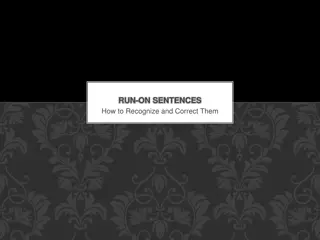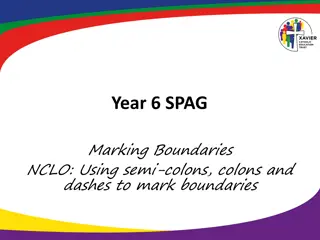Mastering the Use of Semicolons and Colons in Writing
Learn how to effectively use semicolons and colons in your writing with clear examples and guidelines. Discover the nuances of joining sentences, listing items, and common mistakes to avoid when using these punctuation marks.
Download Presentation

Please find below an Image/Link to download the presentation.
The content on the website is provided AS IS for your information and personal use only. It may not be sold, licensed, or shared on other websites without obtaining consent from the author. Download presentation by click this link. If you encounter any issues during the download, it is possible that the publisher has removed the file from their server.
E N D
Presentation Transcript
Semicolons & Colons Adapted from Real Good Grammar, Too by Mamie Webb Hixon
Semicolons Joining Sentences Use a semicolon between two complete sentences. Each sentence on either side of the semicolon must be complete with its own subject and verb. Keep in mind that a semicolon functions the same way as a period and a capital letter. Not all poetry is serious and difficult to read and interpret. The poetry of Maya Angelou, for instance, is rhythmic, folksy, and easy to read. In these two sentences, the content is closely related, so we can tie them together by substituting a semicolon for the period and the capital letter. Not all poetry is serious and difficult to read and interpret; the poetry of Maya Angelou, for instance, is rhythmic, folksy, and easy to read.
Semicolons Joining Sentences Use a semicolon between two complete sentences connected by words such as however, therefore, consequently, nevertheless, and then. Dr. Jones created an information sheet to help her patients use their medication properly; however, her patients blood tests did not reflect improvement. Dr. Jones created an information sheet to help her patients use their medication properly is a complete sentence. However, her patients blood tests did not reflect improvement is also a complete sentence. The introductory element however doesn t change anything; we can still use a semicolon to tie the two sentences together.
Semicolons with Items in a List Use a semicolon between items in a series when the items have internal commas. I bought an old, dilapidated chair; a mahogany table, which was in beautiful condition; and an ugly rug. There are three items in the sentence above: the chair, the table, and the rug. Because there are commas between adjectives describing the items, commas between the items themselves might get lost in a sea of commas, obscuring the number of items in the list. In this situation, semicolons are super- commas, providing next-level punctuation to help us sort out our furniture purchases. We are thinking about moving to Omaha, Nebraska; Gainesville, Florida; or Memphis, Tennessee. If we had used commas to separate the three locations in this sentence, the internal commas separating the cities from the states would have made it difficult to tell if there were three locations or six.
Semicolon No-Nos Do not use a semicolon between an independent clause and a phrase or a dependent clause. You should not make such inflammatory statements; although they are correct. Although they are correct is not a complete sentence.
Semicolon No-Nos Do not use a semicolon interchangeably with a comma. I enjoy sports; particularly tennis, soccer, and fishing. Particularly tennis, soccer, and fishing is not a complete sentence.
Semicolon No-Nos Do not use a semicolon to substitute for a colon. The military expects one thing from its rank and file; obedience. Obedience is not a complete sentence.
Colons with Items in a List Use a colon between a complete sentence and a list or explanation. Note that a complete sentence must precede the colon. There is one common disease on this campus: computer viruses. The players came from all over the world: Germany, Russia, Japan, Canada, and Australia. Just one item, computer viruses, constitutes a list in the first sentence. With five countries in the list, the second sentence better fits our common understanding of a list.
Colons with Items in a List Use a colon with a list even if the positions of the list and the complete sentence are reversed. These are all words that describe my first few days in college: impressive, overwhelming, exciting, surprising. Impressive, overwhelming, exciting, surprising: these are all words that describe my first few days in college. Sometimes, reversing the order of the introductory statement and the list creates a rhetorically effective sentence.
Colons with the Following Use a colon after the following and as follows : The workshop will include the following topics: anger management, stress management, communication skills, and sexual harassment awareness. The portion of this sentence that comes before the colon is a complete sentence. The portion that comes after the colon is a parallel list.
Colons Joining Sentences Use a colon to separate two closely related sentences without a conjunction. Ian was dissatisfied with the photos he had taken: all of them were out of focus. Ian was dissatisfied with the photos he had taken is a complete sentence. All of them were out of focus is a complete sentence that explains something important about the first sentence. We use a colon instead of a semicolon here because the second sentence does more than just continue the thought as it would with a semicolon: the second sentence offers a necessary explanation that completes the thought.
Colons with Quotations Use a colon preceding a formal quotation that is a complete sentence. David always offered the same response to questions about his relationship with Gracie: It s nunya business. Note that there are complete sentences on both sides of the colon.
Colon No-Nos Do not place a colon before or after namely, or for example. We agreed to the plan, namely, to give Joseph a surprise party. A colon is shorthand for words like namely and for example, so using a colon with those words would be redundant. A colon would also effectively end the sentence at namely, making the first portion of the sentence a fragment.
Colon No-Nos Do not place a colon after a verb (are, include, etc.) unless the sentence ends with a verb. The components of this history course are lecture, recitation, and laboratory. Lecture, recitation, and laboratory are the objects of this sentence; a colon would effectively end the sentence at are, making the first portion of the sentence a fragment. There are two things that make us what we are: our heredity and our environment. The part of the sentence before the colon is a complete sentence that ends with the verb are. In this case, the colon does not create a fragment.
Colon No-No's Do not place a colon after a preposition (such as, with, etc.). Included in our curriculum are many of the physical sciences such as engineering, biology, and chemistry. A colon preceding the list of sciences would effectively end the sentence at such as, making the first portion of the sentence a fragment.























